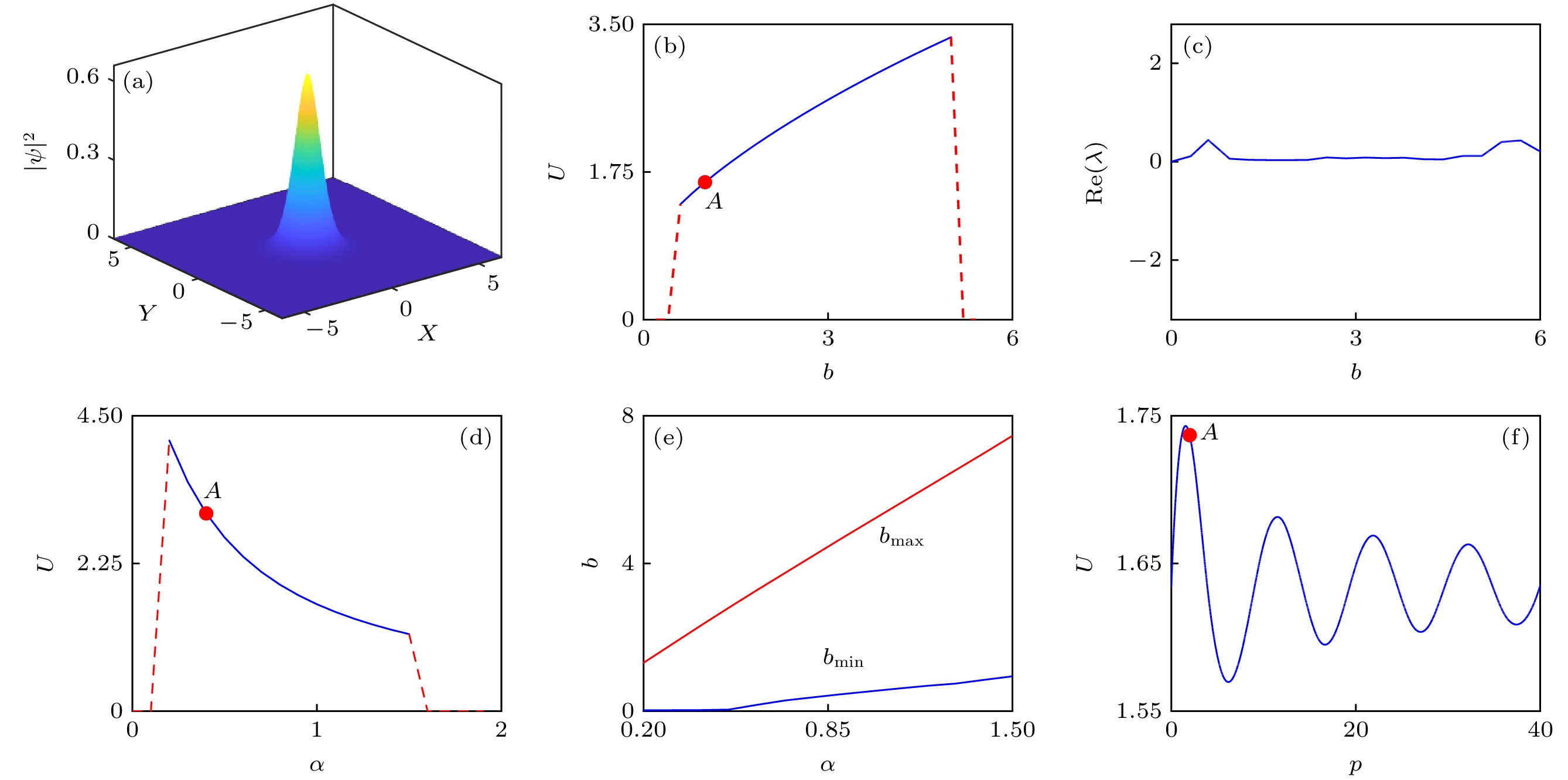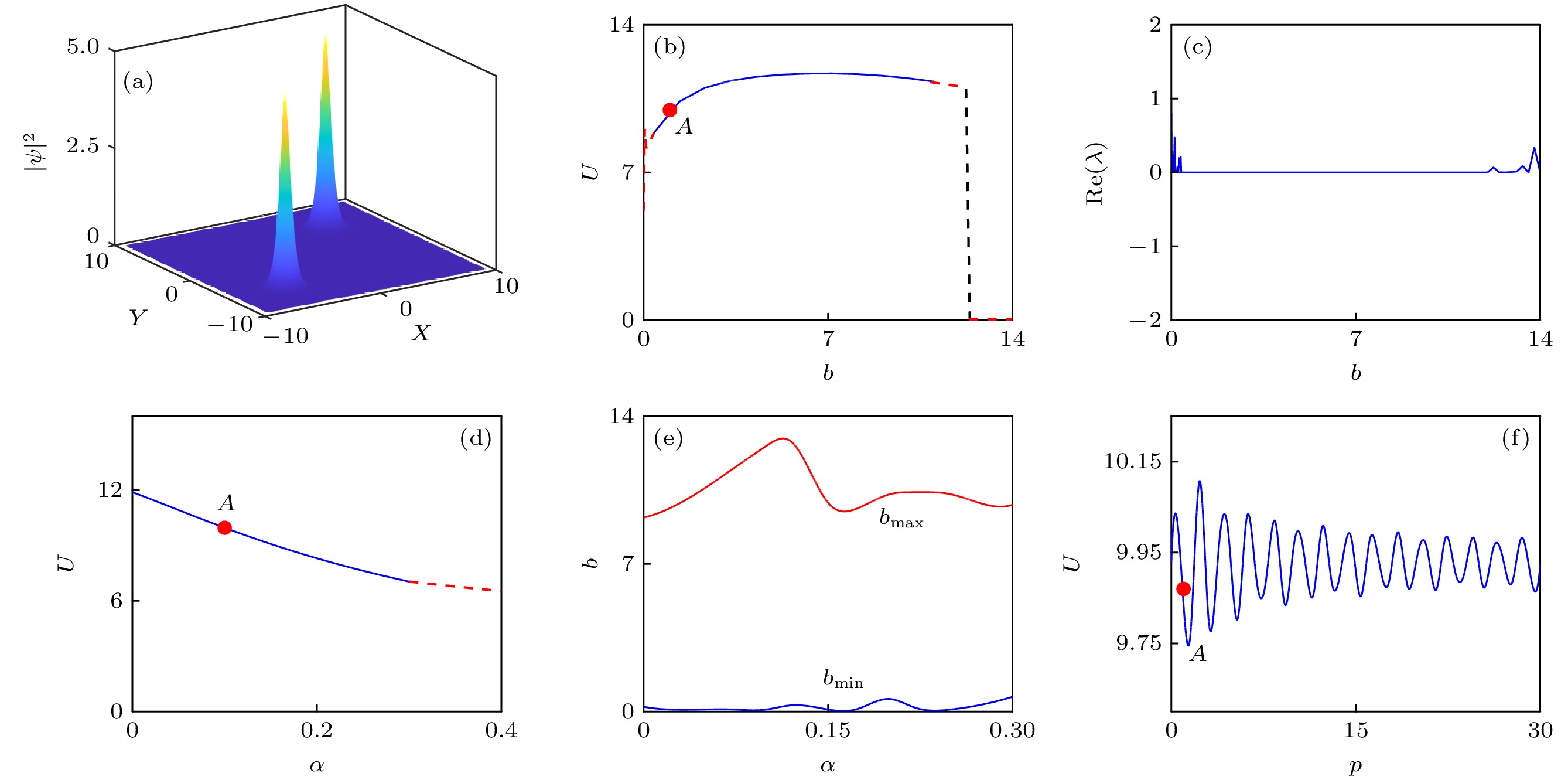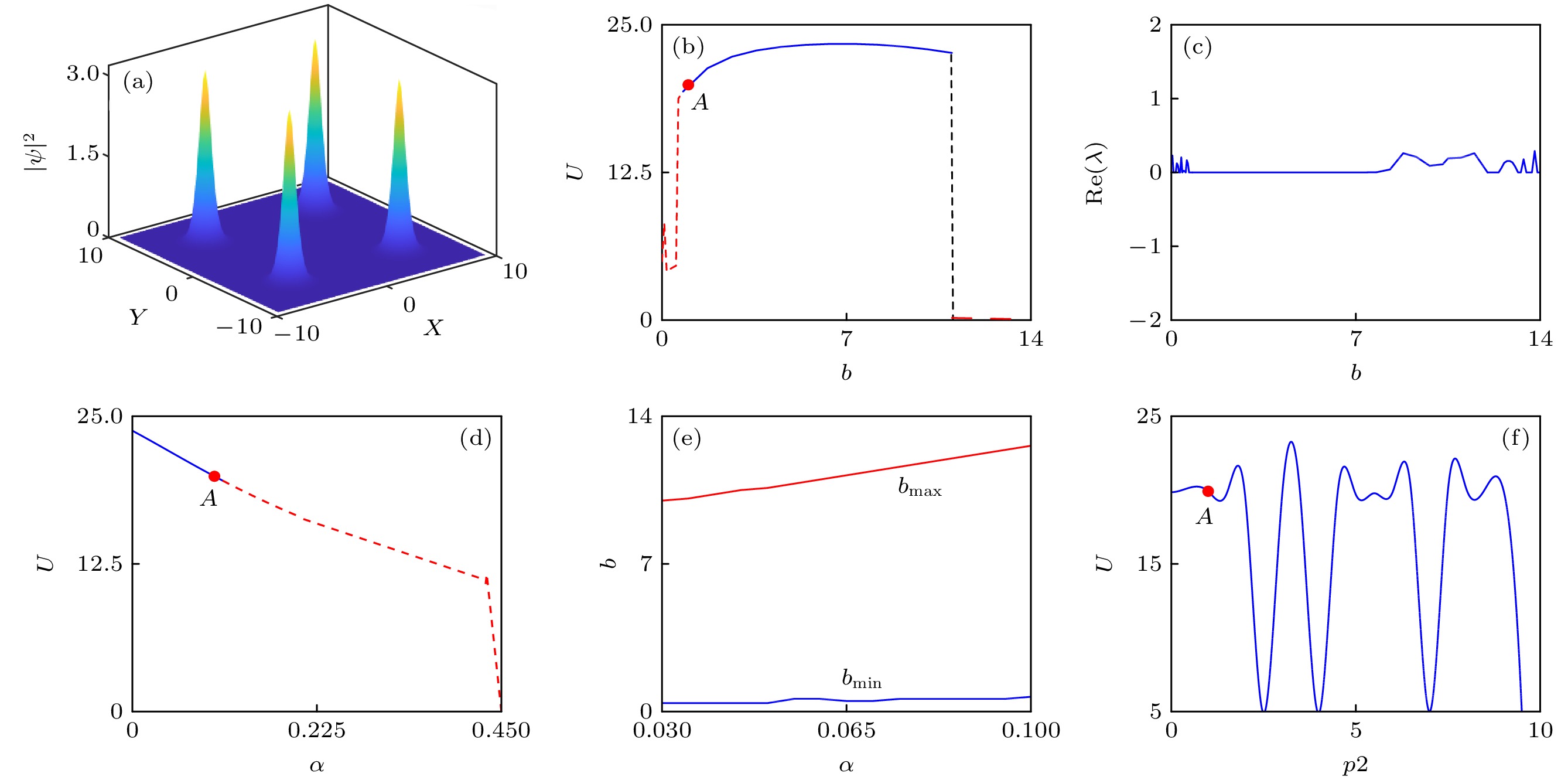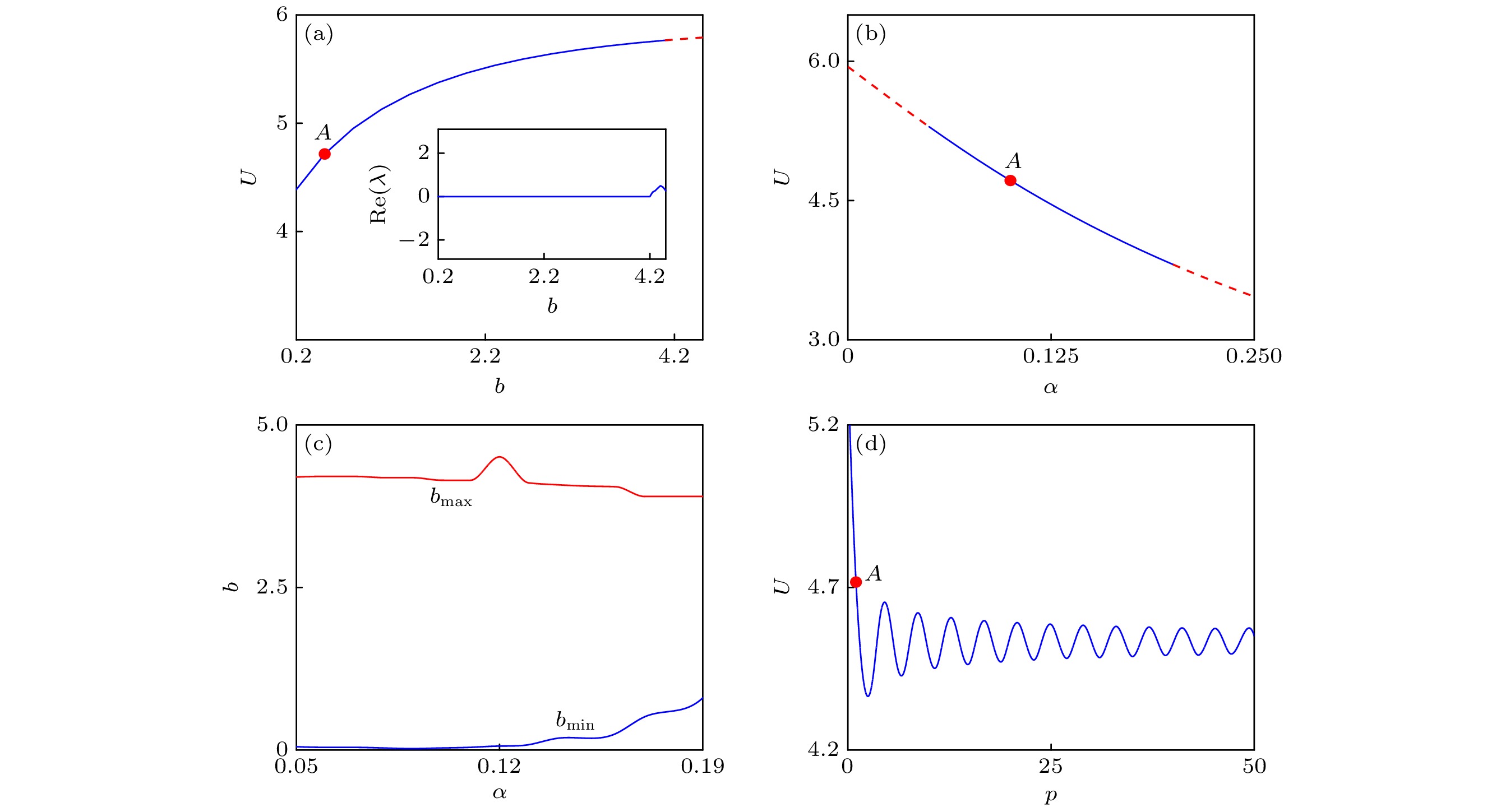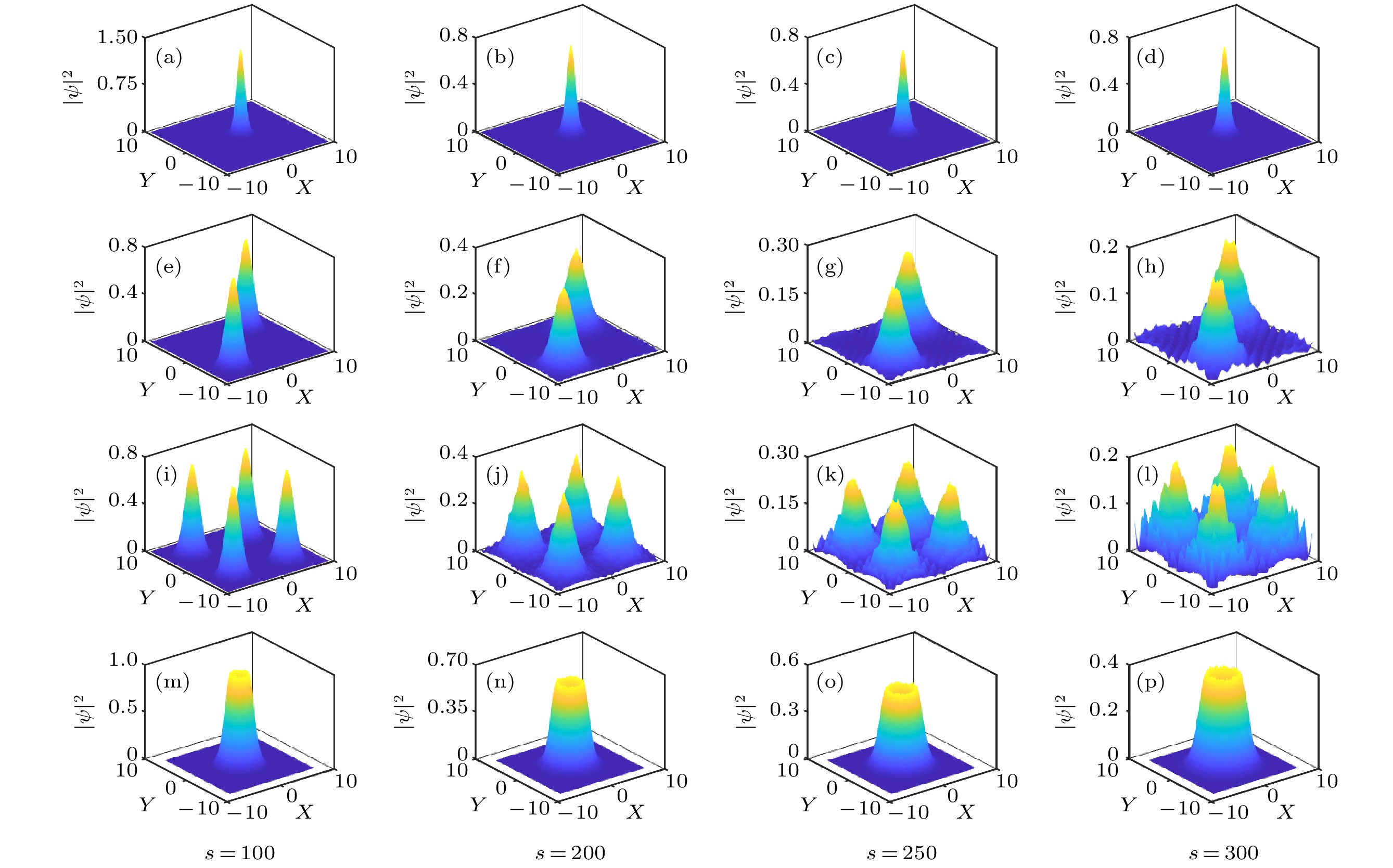-
Realizing stable high-dimensional light solitons is a long-standing goal in the study of nonlinear optical physics. However, in high-dimensional space, the light field will inevitably be distorted due to diffraction. In order to solve the diffraction effect in nonlinear Kerr media and achieve the spatial localization of light fields, we propose a scheme to generate stable two-dimensional (2D) solitons in a cold Rydberg atomic system with a Bessel optical lattice, where a three-level atomic structure, a weak probe laser field, and a strong control field constitute the Rydberg-dressed atomic system. When the local nonlinearity, Bessel potential, and nonlocal nonlinearity which is caused by the long-range Rydberg-Rydberg interaction (RRI) between Rydberg atoms are balanced, the probe field can be localized. Under the approximation of electric dipole and rotating wave, the stable solution of probe field is obtained by solving Maxwell-Bloch equations numerically. A cluster of 2D spatial solitons, including fundamental, two-pole, quadrupole and vortex solitons, is found in this system. Among them, the fundamental, dipole and quadrupole have, one, two, and four intensity centers, respectively. Vortex solitons, on the other hand, exhibit vertical characters in profiles and phase structures. The formation and transmission of these solitons can be controlled by system parameters, such as the propagation coefficient, the degree of nonlocal nonlinearity, and Bessel lattice strength. The stable regions of these solitons are determined by anti Vakhitov Kolokolov (anti-VK) criterion and linear stability analysis method. It is found that four kinds of solitons can be generated and stably propagate in space with proper parameters. Owing to the different structures of the poles, the fundamental state and vortex state remain stable, while the quadrupole ones are unstable. In the modulation of solitons, there is a cutoff value of propagation constant
${b_{{\text{co}}}}$ , only below which value, the solitons can propagate stably. The light intensity of soliton shows a periodic behavior by tuning Bessel lattice strength. The period of the intensity decreases with the order of the solitons as a result of the interaction between the poles. It is also found that the solitons are more stable with weak nonlocal nonlinearity coefficient. This study provides a new idea for the generation and regulation of optical solitons in high dimensional space.-
Keywords:
- Rydberg cold atomic atoms /
- Bessel optical lattice /
- spatial solitons
[1] Zakharov V E, Manakov S V, Novikov S P, Pitaevskii L P 1980 Theory of Solitons: The Inverse Problem Method (Moscow: Nauka Publishers) p256
[2] Ablowitz M J, Segur H 1981 Solitons and the Inverse Scattering Transform (Philadelphia: SIAM) p1
[3] Bludov Y V, Hang C, Huang G, Konotop V V 2014 Opt. Lett. 39 3382
 Google Scholar
Google Scholar
[4] Bergé L 1998 Phys. Rep. 303 259
 Google Scholar
Google Scholar
[5] Fibich G 2015 The Nonlinear Schrödinger Equation: Singular Solutions and Optical Collapse (Berlin: Springer) p1
[6] Li B B, Zhao Y, Xu S L, Zhou Q, Fu Q D, Ye F W, Hua C B, Chen M W, Hu H J, Zhou Q Q, Qiu Z C 2023 Chin. Phys. Lett. 40 044201
 Google Scholar
Google Scholar
[7] Malomed B A 2019 Physcia D 399 108
 Google Scholar
Google Scholar
[8] Edmundson D E, Enns R H 1992 Opt. Lett. 17 586
 Google Scholar
Google Scholar
[9] Kanashov A A, Rubenchik A M 1981 Physica D 4 122
 Google Scholar
Google Scholar
[10] Liu X, Qian L J, Wise F W 1999 Phys. Rev. Lett. 82 4631
 Google Scholar
Google Scholar
[11] Quiroga-Teixeiro M, Michinel H 1997 J. Opt. Soc. Am. B 14 2004
 Google Scholar
Google Scholar
[12] Mihalache D, Mazilu D, Crasovan L C, Towers I, Buryak A V, Malomed B A, Torner L, Torres J P, Lederer F 2002 Phys. Rev. Lett. 88 073902
 Google Scholar
Google Scholar
[13] Bang O, Krolikowski W, Wyller J, Rasmussen J J 2002 Phys. Rev. E 66 046619
 Google Scholar
Google Scholar
[14] 秦晓娟, 郭旗, 胡巍, 兰胜 2006 物理学报 55 1237
 Google Scholar
Google Scholar
Qin X J, Guo Q, Hu W, Lan S 2006 Acta Phys. Sin. 55 1237
 Google Scholar
Google Scholar
[15] Burgess I B, Peccianti M, Assanto G, Morandotti R 2009 Phys. Rev. Lett. 102 203903
 Google Scholar
Google Scholar
[16] Mandel O, Greiner M, Widera A, Rom T, Hänsch T W, Bloch I 2003 Nature 425 937
 Google Scholar
Google Scholar
[17] 潘楠, 黄平, 黄龙刚, 雷鸣, 刘文军 2015 物理学报 64 090504
 Google Scholar
Google Scholar
Pan N, Huang P, Huang L G, Lei M, Liu W J 2015 Acta Phys. Sin. 64 090504
 Google Scholar
Google Scholar
[18] Zhao Y, Lei Y B, Xu Y X, Xu S L, Triki H, Biswas A, Zhou Q 2022 Chin. Phys. Lett. 39 034202
 Google Scholar
Google Scholar
[19] Skupin S, Saffman M, Królikowski W 2007 Phys. Rev. Lett. 98 263902
 Google Scholar
Google Scholar
[20] Sevinçli S, Henkel N, Ates C, Pohl T 2011 Phys. Rev. Lett. 107 153001
 Google Scholar
Google Scholar
[21] Horikis T P, Frantzeskakis D J 2017 Phys. Rev. Lett. 118 243903
 Google Scholar
Google Scholar
[22] Wilson K E, Westerberg N, Valiente M, Duncan C W, Wright E M, Öhberg P, Faccio D 2018 Phys. Rev. Lett. 121 133903
 Google Scholar
Google Scholar
[23] 高洁, 杭超 2022 物理学报 71 133202
 Google Scholar
Google Scholar
Gao J, Hang C 2022 Acta Phys. Sin. 71 133202
 Google Scholar
Google Scholar
[24] Falcao-Filho E L, de Araújo C B, Boudebs G, Leblond H, Skarka V 2013 Phys. Rev. Lett. 110 013901
 Google Scholar
Google Scholar
[25] Cabrera C R, Tanzi L, Sanz J, Naylor B, Thomas P, Cheiney P, Tarruell L 2018 Science 359 301
 Google Scholar
Google Scholar
[26] Cheiney P, Cabrera C R, Sanz J, Naylor B, Tanzi L, Tarruell L 2018 Phys. Rev. Lett. 120 135301
 Google Scholar
Google Scholar
[27] Semeghini G, Ferioli G, Masi L, Mazzinghi C, Wolswijk L, Minardi F, Modugno M, Modugno G, Inguscio M, Fattori M 2018 Phys. Rev. Lett. 120 235301
 Google Scholar
Google Scholar
[28] Reyna A S, Boudebs G, Malomed B A, de Araújo C B 2016 Phys. Rev. A 93 013840
 Google Scholar
Google Scholar
[29] Li H, Xu S L, Belić M R, Cheng J X 2018 Phys. Rev. A 98 033827
 Google Scholar
Google Scholar
[30] Qin J, Dong G, Malomed B A 2016 Phys. Rev. A 94 053611
 Google Scholar
Google Scholar
[31] Qin J, Liang Z, Malomed B A, Dong G 2019 Phys. Rev. A 99 023610
 Google Scholar
Google Scholar
[32] Fleischhauer M, Imamoglu A, Marangos J P 2005 Rev. Mod. Phys. 77 633
 Google Scholar
Google Scholar
[33] Busche H, Huillery P, Ball S W, Ilieva T, Jones M P A, Adams C S 2017 Nat. Phys. 13 655
 Google Scholar
Google Scholar
[34] Singer K, Stanojevic J, Weidemüler M, Côté R 2005 J. Phys. B 38 S295
 Google Scholar
Google Scholar
[35] Guo Y W, Xu S L, He J R, Deng P, Belić M R, Zhao Y 2020 Phys. Rev. A 101 023806
 Google Scholar
Google Scholar
[36] Sakaguchi H, Malomed B A 2010 Phys. Rev. A 81 013624
 Google Scholar
Google Scholar
[37] Huang K Y, Zhao Y, Wu S Q, Xu S L, Belić M R, Malomed B A 2022 Chaos, Solitons and Fractals 163 112557
 Google Scholar
Google Scholar
-
图 1 里德伯原子与贝塞尔晶格相互作用模型 (a) 三能级里德伯原子能级结构. 探测光(半拉比频率
$ {\varOmega _{\rm{p}}} $ )耦合能级$ \left| 1 \right\rangle $ 和$ \left| 2 \right\rangle $ , 控制光(半拉比频率$ {\varOmega _{\rm{c}}} $ )耦合能级$ \left| 2 \right\rangle $ 和$ \left| 3 \right\rangle $ ,${\varDelta _2}$ 和$ {\varDelta _3} $ 分别是单光子失谐量和双光子失谐量,$ {\varGamma _{12}} $ 和$ {\varGamma _{23}} $ 分别是能级$ \left| 2 \right\rangle \to \left| 1 \right\rangle $ 和$ \left| 3 \right\rangle \to \left| 2 \right\rangle $ 的自发辐射率,$ V({\boldsymbol{r}} - {\boldsymbol{r}}{\mathbf{'}}) $ 表示两个位矢分别是$ {\boldsymbol{r}} $ 和$ {\boldsymbol{r}}{\mathbf{'}} $ 的里德伯原子之间的长程相互作用势. (b) 里德伯阻塞效应示意图. 里德伯原子之间的长程相互作用阻碍了阻塞球内原子的激发, 其阻塞边界用红色虚线表示, 阻塞半径(里德伯半径)为$ {R_{\rm{b}}} $ . 每个阻塞球内只有一个原子(黄色球)被激发到里德伯态. (c) 贝塞尔晶格势的空间分布, 本文采用一阶贝塞尔函数Fig. 1. Model of Rydberg atomic system with Bessel optical lattices. (a) Atomic level structures of three-level Rydberg atoms. One probe field (half-Rabi frequency
$ {\varOmega _{\rm{p}}} $ ) couples states$ \left| 1 \right\rangle $ and$ \left| 2 \right\rangle $ . One control field (half-Rabi frequency$ {\varOmega _{\rm{c}}} $ ) couples states$ \left| 2 \right\rangle $ and$ \left| 3 \right\rangle $ .${\varDelta _2}$ and${\varDelta _3}$ are the single-photon and two-photon detunings, respectively.$ {\varGamma _{12}} $ and$ {\varGamma _{23}} $ are the spontaneous emission decay rates from$ \left| 2 \right\rangle \to \left| 1 \right\rangle $ and$ \left| 3 \right\rangle \to \left| 2 \right\rangle $ respectively.$ V({\boldsymbol{r}} - {\boldsymbol{r}}{\mathbf{'}}) $ is the interaction potential of two Rydberg atoms. (b) Schematic diagram of Rydberg blockade effect. The long-range interaction between Rydberg atoms blocks the the excitation of atom in the blockade sphere (with radius$ {R_{\rm{b}}} $ ). Only one atom (yellow) in the blockade sphere can be excited to Rydberg state. (c) Spatial distribution of Bessel lattice potential. The one-order Bessel function is adopted in this work.图 2 基极孤子调制及稳定性分析 (a)孤子的空间强度分布; (b)光强随传播系数的变化; (c)本征值实部及稳定性; (d)光强随非局域非线性系数的变化; (e)非局域非线性系数调制下传播系数稳定性区间; (f)光强随贝塞尔晶格强度的变化. 图中实线表示光孤子稳定存在, 虚线表示光孤子形态不稳定, 点A对应图(a)基极孤子的参数取值, 即b = 1, α = 1, p = 4
Fig. 2. Modulation of fundamental solitons and their stability: (a) Intensity distribution of fundamental solitons; (b) light intensity of probe filed with respect to transport coefficient b; (c) stability analysis of fundamental solitons; (d) light intensity vs. nonlocal nonlinear coefficient α; (e) stable zone with respect to b and α; (f) light intensity as a function of Bessel lattice strength p. The solid and dash lines represent the stable and unstable state, respectively. Point A is the state of profile panel (a) with system parameters: b = 1, α = 1, p = 4.
图 3 二极孤子调制及其稳定性 (a)孤子的空间强度分布; (b)光强随传播系数的变化; (c)本征值实部与传播系数的关系; (d)光强随非局域非线性系数的变化; (e)非局域非线性系数调制下传播系数稳定性区间; (f)光强随贝塞尔晶格强度的变化. 图中点A表示图(a)二极孤子的参数取值, 即 b = 1, α = 0.1, p = 1
Fig. 3. Modulation of two-pole solitons and their stability: (a) Profile of two-pole solitons; (b) light intensity of probe filed with respect to transport coefficient b; (d) nonlocal nonlinear coefficient α; (f) Bessel lattice strength p; (c) stability analysis of fundamental solitons; (e) stable zone with respect to b and α. The solid and dash lines represent the stable and unstable state, respectively. Point A is the state of profile panel (a) with system parameters: b = 1, α = 0.1, p = 1.
图 4 四极孤子调制及其稳定性 (a) 孤子的空间强度分布; (b) 光强随传播系数的变化; (c) 本征值实部随传播系数的变化关系; (d) 光强随非局域非线性系数的变化; (e) 非局域非线性系数调制下传播系数稳定性区间; (f) 光强随贝塞尔晶格强度的变化. 图(d)中点A表示图(a)中四极孤子的参数取值, 即 b = 1, α = 0.1, p = 1
Fig. 4. Modulation of quadrupole solitons and their stability: (a) Profile of quadrupole solitons; (b) light intensity of probe filed with respect to transport coefficient b; (c) stability analysis of quadrupole solitons; (d) light intensity vs. nonlocal nonlinear coefficient α; (e) stable zone with respect to b and α; (f) light intensity as a function of Bessel lattice strength p. The solid and dash lines represent the stable and unstable state, respectively. Point A in panel (d) is the state of profile panel (a) with system parameters: b = 1, α = 0.1, p = 1.
图 5 涡旋孤子的形态及相位分布 (a), (b) 涡旋孤子强度的空间分布及平面投影; (c) 涡旋孤子的相位分布. 图中涡旋孤子的参数取值: b = 0.5, α = 0.1, p = 1
Fig. 5. Profile of vortex solitons and their phase structure: (a), (b) Intensity distribution of vortices and its projection in (x, y) plane; (c) phase distribution of vortex solitons. The parameters of vortices here are b = 0.5, α = 0.1, p = 1.
图 6 涡旋孤子的调制 (a) 光强随传播系数的变化, 内置图表示本征值实部随传播系数的关系; (b) 光强随非局域非线性系数的变化; (c) 非局域非线性系数调制下传播系数的取值范围; (d) 光强随贝塞尔晶格强度的变化. 图中点A的参数与图5相同
Fig. 6. Modulation of vortex solitons: (a) Light intensity vs. transport coefficient, and the illustration shows relationship between the real part of eigenvalue and propagation coefficient; (b) light intensity vs. nonlocal nonlinear coefficient; (c) value range of propagation coefficient under non-local nonlinear coefficient modulation; (d) light intensity vs. Bessel lattice strength. Point A has the same parameters with Fig. 5.
图 7 光孤子簇的光强随传播距离的演化, 传播距离取s = 100, 200, 250, 300 (a)—(d) 基极孤子; (e)—(h) 二极孤子; (i)—(l) 四极孤子; (m)—(p) 涡旋孤子
Fig. 7. Evolution of four kinds of solitons with propagation distances s = 100, 200, 250, 300: (a)–(d) fundamental solitons; (e)–(h) two-pole solitons; (i)–(l) quadrupole solitons; (m)–(p) vortex solitons.
-
[1] Zakharov V E, Manakov S V, Novikov S P, Pitaevskii L P 1980 Theory of Solitons: The Inverse Problem Method (Moscow: Nauka Publishers) p256
[2] Ablowitz M J, Segur H 1981 Solitons and the Inverse Scattering Transform (Philadelphia: SIAM) p1
[3] Bludov Y V, Hang C, Huang G, Konotop V V 2014 Opt. Lett. 39 3382
 Google Scholar
Google Scholar
[4] Bergé L 1998 Phys. Rep. 303 259
 Google Scholar
Google Scholar
[5] Fibich G 2015 The Nonlinear Schrödinger Equation: Singular Solutions and Optical Collapse (Berlin: Springer) p1
[6] Li B B, Zhao Y, Xu S L, Zhou Q, Fu Q D, Ye F W, Hua C B, Chen M W, Hu H J, Zhou Q Q, Qiu Z C 2023 Chin. Phys. Lett. 40 044201
 Google Scholar
Google Scholar
[7] Malomed B A 2019 Physcia D 399 108
 Google Scholar
Google Scholar
[8] Edmundson D E, Enns R H 1992 Opt. Lett. 17 586
 Google Scholar
Google Scholar
[9] Kanashov A A, Rubenchik A M 1981 Physica D 4 122
 Google Scholar
Google Scholar
[10] Liu X, Qian L J, Wise F W 1999 Phys. Rev. Lett. 82 4631
 Google Scholar
Google Scholar
[11] Quiroga-Teixeiro M, Michinel H 1997 J. Opt. Soc. Am. B 14 2004
 Google Scholar
Google Scholar
[12] Mihalache D, Mazilu D, Crasovan L C, Towers I, Buryak A V, Malomed B A, Torner L, Torres J P, Lederer F 2002 Phys. Rev. Lett. 88 073902
 Google Scholar
Google Scholar
[13] Bang O, Krolikowski W, Wyller J, Rasmussen J J 2002 Phys. Rev. E 66 046619
 Google Scholar
Google Scholar
[14] 秦晓娟, 郭旗, 胡巍, 兰胜 2006 物理学报 55 1237
 Google Scholar
Google Scholar
Qin X J, Guo Q, Hu W, Lan S 2006 Acta Phys. Sin. 55 1237
 Google Scholar
Google Scholar
[15] Burgess I B, Peccianti M, Assanto G, Morandotti R 2009 Phys. Rev. Lett. 102 203903
 Google Scholar
Google Scholar
[16] Mandel O, Greiner M, Widera A, Rom T, Hänsch T W, Bloch I 2003 Nature 425 937
 Google Scholar
Google Scholar
[17] 潘楠, 黄平, 黄龙刚, 雷鸣, 刘文军 2015 物理学报 64 090504
 Google Scholar
Google Scholar
Pan N, Huang P, Huang L G, Lei M, Liu W J 2015 Acta Phys. Sin. 64 090504
 Google Scholar
Google Scholar
[18] Zhao Y, Lei Y B, Xu Y X, Xu S L, Triki H, Biswas A, Zhou Q 2022 Chin. Phys. Lett. 39 034202
 Google Scholar
Google Scholar
[19] Skupin S, Saffman M, Królikowski W 2007 Phys. Rev. Lett. 98 263902
 Google Scholar
Google Scholar
[20] Sevinçli S, Henkel N, Ates C, Pohl T 2011 Phys. Rev. Lett. 107 153001
 Google Scholar
Google Scholar
[21] Horikis T P, Frantzeskakis D J 2017 Phys. Rev. Lett. 118 243903
 Google Scholar
Google Scholar
[22] Wilson K E, Westerberg N, Valiente M, Duncan C W, Wright E M, Öhberg P, Faccio D 2018 Phys. Rev. Lett. 121 133903
 Google Scholar
Google Scholar
[23] 高洁, 杭超 2022 物理学报 71 133202
 Google Scholar
Google Scholar
Gao J, Hang C 2022 Acta Phys. Sin. 71 133202
 Google Scholar
Google Scholar
[24] Falcao-Filho E L, de Araújo C B, Boudebs G, Leblond H, Skarka V 2013 Phys. Rev. Lett. 110 013901
 Google Scholar
Google Scholar
[25] Cabrera C R, Tanzi L, Sanz J, Naylor B, Thomas P, Cheiney P, Tarruell L 2018 Science 359 301
 Google Scholar
Google Scholar
[26] Cheiney P, Cabrera C R, Sanz J, Naylor B, Tanzi L, Tarruell L 2018 Phys. Rev. Lett. 120 135301
 Google Scholar
Google Scholar
[27] Semeghini G, Ferioli G, Masi L, Mazzinghi C, Wolswijk L, Minardi F, Modugno M, Modugno G, Inguscio M, Fattori M 2018 Phys. Rev. Lett. 120 235301
 Google Scholar
Google Scholar
[28] Reyna A S, Boudebs G, Malomed B A, de Araújo C B 2016 Phys. Rev. A 93 013840
 Google Scholar
Google Scholar
[29] Li H, Xu S L, Belić M R, Cheng J X 2018 Phys. Rev. A 98 033827
 Google Scholar
Google Scholar
[30] Qin J, Dong G, Malomed B A 2016 Phys. Rev. A 94 053611
 Google Scholar
Google Scholar
[31] Qin J, Liang Z, Malomed B A, Dong G 2019 Phys. Rev. A 99 023610
 Google Scholar
Google Scholar
[32] Fleischhauer M, Imamoglu A, Marangos J P 2005 Rev. Mod. Phys. 77 633
 Google Scholar
Google Scholar
[33] Busche H, Huillery P, Ball S W, Ilieva T, Jones M P A, Adams C S 2017 Nat. Phys. 13 655
 Google Scholar
Google Scholar
[34] Singer K, Stanojevic J, Weidemüler M, Côté R 2005 J. Phys. B 38 S295
 Google Scholar
Google Scholar
[35] Guo Y W, Xu S L, He J R, Deng P, Belić M R, Zhao Y 2020 Phys. Rev. A 101 023806
 Google Scholar
Google Scholar
[36] Sakaguchi H, Malomed B A 2010 Phys. Rev. A 81 013624
 Google Scholar
Google Scholar
[37] Huang K Y, Zhao Y, Wu S Q, Xu S L, Belić M R, Malomed B A 2022 Chaos, Solitons and Fractals 163 112557
 Google Scholar
Google Scholar
计量
- 文章访问数: 5060
- PDF下载量: 165
- 被引次数: 0













































 下载:
下载:
